|
|
 |
Fiche d'espèce de Copépode |
|
|
Cyclopoida ( Ordre ) |
|
|
|
Corycaeidae ( Famille ) |
|
|
|
Corycaeus ( Genre ) |
|
|
|
Agetus ( Sous-Genre ) |
|
|
| |
Corycaeus (Agetus) limbatus Brady, 1883 (F,M) | |
| | | | | | | Syn.: | Corycäus elongatus : Giesbrecht, 1892, (part., p.674, Pl.49, figs.13, 15, 17, 38, Pl. 51, fig.6, ?7: F, no figs.35, 53: M);
Agetus limbatus : Dessier, 1983 (p.89, Tableau 1, Rem., %); Boxshall & Halsey, 2004 (p.494) ; Böttger-Schnack, 1997 (p.409); ; McKinnon & al., 2008 (p.843: Tab.1); Vidjak & Bojanic, 2009 (p.432, Table II, IV, V); Lan Y.-C. & al., 2009 (p.1, Table 2, % vs hydrogaphic conditions); Isari & al., 2011 (p.51, Table 2, abundance vs distribution); Belmonte & al., 2013 (p.222, Table 2, abundance vs stations); Wi & al., 2013 (p.411, figs.F,M, Table 2Rem. p.415 & following); Zakaria & al., 2016 (p.1, Table 1); El Arraj & al., 2017 (p.272, table 2, spatial distribution);
Corycaeus limbatus : Corral Estrada & Pereiro Muñoz, 1974 (tab.I); Avancini & al., 2006 (p.148, Pl. 116, figs.F,M, Rem.); Jerez-Guerrero & al., 2017 (p.1046, Table 1: temporal occurrence) | | | | Ref.: | | | Brady, 1883 (part., p.114, figs.F,M); F. Dahl, 1894 (p.70); M. Dahl, 1912 (p.38, figs.F,M); Farran, 1929 (p.211, 293); Rose, 1929 (p.69); 1933 a (p.328, figs.F,M); Klevenhusen, 1933 a (p.91, carte 43); Farran, 1936 a (p.136); Tanaka, 1957 (p.83, figs.F,M); Marques, 1958 a (p.145, figs.F, Rem.); Fagetti, 1962 (p.53); Motoda, 1963 (p.229, figs.M); Cervigon, 1964 (p.172, figs.F,M); Owre & Foyo, 1967 (p.121, figs.F,M); Vilela, 1968 (p.36, figs.F,M); Razouls, 1972 (p.96, Annexe: p.129, figs.M); 1974 c (1975) (p.86, figs. M); Corral Estrada, 1970 (p.239, figs.F,M); Björnberg & al., 1981 (p.675, figs.F,M); Lakkis & Zeidane, 1987 (p. 18, figs.F, M, Rem.); Boxshall, 1998 (p.222); Chihara & Murano, 1997 (p.964, Pl.215: F,M); Bradford-Grieve & al., 1999 (p.887, 974, figs.F,M); | 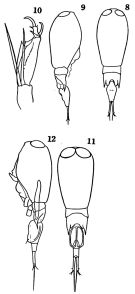 issued from : O. Tanaka in J. Fac. Agricult. Kyushu Univ., 1957, 11 (1). [Pl.5, Figs.8-12]. Female (from Japanese waters): 8, habitus (dorsal); 9, idem (lateral right side); 10, A2. Nota: One-segmented abdomen is 2 times as long as furcal rami. The rhomboidal form of genital segment in dorsal view is a good specific character. Male: 11, habitus (dorsal); 12, idem (lateral left side). Nota: Anterior segment less than 2 times as long as wide (7:4). The abdominal segments and furca in the proportional lengths 52:17:29. Large cuticular lenses contiguous . Genital segment about 1.6 times as long as wide (27:17). Anal segment 1.5 as long as wide.
|
 issued from : C. Razouls in Vie Milieu, 1974, 24 (1.A). [p.101, Fig.3]. Male (from W Medit.: Banyuls, France): A, A2; B, P1; C, Mxp; D, P4; E, P2; F, P3.
|
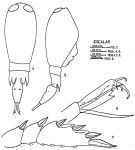 issued from : J. Corral Estrada in Tesis Doct., Univ. Madrid, A-129, Sec. Biologicas, 1970. [Lam.58, figs.4-7]. Female (from Canarias Is.): 4, habitus (dorsal); 5, idem (lateral right side); 6, A2; 7, exopodal segments of P1.
|
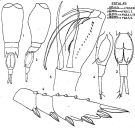 issued from : J. Corral Estrada in Tesis Doct., Univ. Madrid, A-129, Sec. Biologicas, 1970. [Lam.59, figs.1-6]. Male: 1, habitus (dorsal); 2, idem (lateral left side); 3, urosome (ventral); 4, idem (latera lleft side); 5, A2; 6, exopodal segments of P1.
|
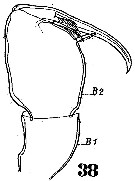 Issued from : W. Giesbrecht in Systematik und Faunistik der Pelagischen Copepoden des Golfes von Neapel und der angrenzenden Meeres-Abschnitte. – Fauna Flora Golf. Neapel, 1892. Atlas von 54 Tafeln. [Taf.49, Fig.38]. As Corycäus elongatus. Female: 38, Mxp.
|
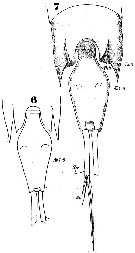 Issued from : W. Giesbrecht in Systematik und Faunistik der Pelagischen Copepoden des Golfes von Neapel und der angrenzenden Meeres-Abschnitte. – Fauna Flora Golf. Neapel, 1892. Atlas von 54 Tafeln. [Taf.51, Figs.6, 7]. As Corycäus elongatus. Female: 6, urosome (dorsal); 7, metasomal segments 3-4 and urosome (dorsal).
|
 Issued from : W. Giesbrecht in Systematik und Faunistik der Pelagischen Copepoden des Golfes von Neapel und der angrenzenden Meeres-Abschnitte. – Fauna Flora Golf. Neapel, 1892. Atlas von 54 Tafeln. [Taf.51, Fig.35]. As Corucäus elongatus. Male: 35, urosome (ventral).
|
 issued from : M. Dahl in Ergebnisse der Plankton-Expedition der Humboldt-Stiftung. Bd II, G. f1. I. Die Corycaeinen 1912. [Taf.V, Figs.12, 13]. Female: 12, habitus (dorsal); 13, idem (lateral right side).
|
 issued from : M. Dahl in Ergebnisse der Plankton-Expedition der Humboldt-Stiftung. Bd II, G. f1. I. Die Corycaeinen 1912. [Taf.V, Fig.14]. Female: A2.
|
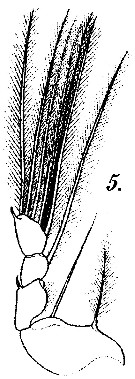 issued from : M. Dahl in Ergebnisse der Plankton-Expedition der Humboldt-Stiftung. Bd II, G. f1. I. Die Corycaeinen 1912. [Taf.VI, Fig.5]. Female: 5, P4.
|
 issued from : M. Dahl in Ergebnisse der Plankton-Expedition der Humboldt-Stiftung. Bd II, G. f1. I. Die Corycaeinen 1912. [Taf.VI, Figs.1, 2]. Male: 1, habitus (dorsal); 2, idem (lateral left side).
|
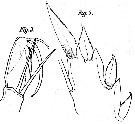 issued from : M. Dahl in Ergebnisse der Plankton-Expedition der Humboldt-Stiftung. Bd II, G. f1. I. Die Corycaeinen 1912. [TafVI, Figs.3, 4]. Male: 3, A2; 4, terminal portion of exopod of P1.
|
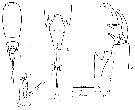 issued from : F. Cervigon iin Mem. Soc. Cienc. nat. La Salle, 1964, 24 (68). [p.173, Lam.6]. As Agetus limbatus. Female (from Venezuela): 1, habitus (dorsal); 2, abdomen (dorsal); 3, A2; 4, distal part of A2. Nota: Lengths ratio abdomen and caudal rami 70:30
|
 issued from : F. Cervigon iin Mem. Soc. Cienc. nat. La Salle, 1964, 24 (68). [p.174, Lam.7]. As Agetus limbatus. Male: 1-2, habitus (dorsal and lateral, respectively); 3, abdomen (dorsal); 4, abdomen (lateral); 5, A2; 6, exopod 3 of P1; 7, P4. Nota: Lengths ratio genital, anal segments and caudal rami 50:18:32 and 51:17:32.
|
 Issued from : G.S. Brady in Rep. Scient. Results Voy. Challenger, Zool., 1883, 8 (23). [Pl. XLIX, Figs.18-22]. Female: 18, habitus (lateral; 19,
|
 Issued from : W. Giesbrecht in Systematik und Faunistik der Pelagischen Copepoden des Golfes von Neapel und der angrenzenden Meeres-Abschnitte. – Fauna Flora Golf. Neapel, 1892. Atlas von 54 Tafeln. [Taf.49, Fig.26]. As Corycäus elongatus. Female: 26, A2.
|
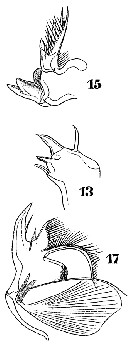 Issued from : W. Giesbrecht in Systematik und Faunistik der Pelagischen Copepoden des Golfes von Neapel und der angrenzenden Meeres-Abschnitte. – Fauna Flora Golf. Neapel, 1892. Atlas von 54 Tafeln. [Taf.49, Figs.13, 15, 17]. As Corycäus elongatus. Female: 13, Mx1; 15, Md; 17, Mx2.
|
 [O & F] Female: Caudal rami approximately 1/2 the length of the urosome. Male: Eyes contiguous. [B & H] Female; Caudal ramus length about half length of urosome in dorsal view. Male: Anal somite 1.5 times longer than wide and 75 % length of caudal rami. Eyes located close together on frontal margin. [V & S] Female: Eyes separayed. Caudal ramus equal half of the abdomen. Male: Eyes contiguous. Anal segment 1.5 times longer than wide and equal to 2/3 of caudal rami.
|
 Issued from J.H. Wi, D.H. Kim & H.Y. Soh in Ocean Sci. J., 2013, 48 (4). [p.412, Fig.8]. As Agetus limbatus. Female (from Jeju Island, S Korea): A, habitus (dorsal); B, 3rd and 4th pedigerous somites, urosome (lateral; arrow indicating small protrusion on dorsal surface); C, 2nd urosomal somite (arrow indicating row of spinules on dorsal surface); D, P5; E, A2; F, Mx1. Scale bars in µm. Nota : Prosome length about twice to that of urosome ibcluding caudal ramus, 3 times of urosome length excluding caudal ramus. - Urosome 2-segmented. 2nd urosomal somite rounded, 2.2 times as loing as maximum wifth at anterio5, ornamented with row of denticles different in size below genital apertures on dorsal surface (indicated by arrow) and with protrusion at anterior 45% distance in lateral view (indicated by arrow - Caudal ramus about twice shorter than 2nd urosomal somite, 5.6 times longer than wide at base. Rami slightly divergent. Ramus armed with 6 setae, dorsal setaVII 2.4 times longer thanh outer posterolateral seta III. -A1, Md, Mx2 similarto those of A. typicus. - A2 similar to that of A. typicus, but 1st endopodal segment 3.4 times as long as wide at base, 1st endopodal seta 1.2 times snorter than coxobasal seta. - Mx1 similar to that of A. typicus, but element (A) almost equal to element (B) in length and length ratios of elemenys about 86.4 : 100.0 : 45.5 : 34.5.
|
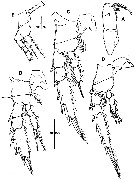 Issued from J.H. Wi, D.H. Kim & H.Y. Soh in Ocean Sci. J., 2013, 48 (4). [p.413, Fig.9]. As Agetus limbatus. Female: A, Mxp; B, P1 (posterior view); C, P2 (posterior view); D, P3 (posterior view); E, P4 (posterior view). Scale bars in µm. Nota : Mxp similar to that of A. typicus female, exceot basal seta located at posterior ¾, and length to width ratio at base larger (2.1) than yjat of A. typicus (1.8 : 1). - P1-P3 similar to that of A. typicus. Exopods of P1-P3 : relative length ratio of distal segment to terminal spine different, in P1 1.8 : 1, in P2 1.7 : 1, and in P3 1.2 : 1, and relative length ratio of terminal spine to distal outer spine different, relatively, P1 smallest (about 1.8 : 1), in P2 2.5 : 1, and P3 largest (4.1). - P4 similar to that of A. typicus, but in exopod, distal spine 1.8 times longer than proximal spine and 2.1 times shorter than distal segment. Basal seta slightly longer than endopodal seta. - P5 comprised of 2 setae : outer one about twice as long as inner one. - P6 represented by operculum closing off each genital aperture.
|
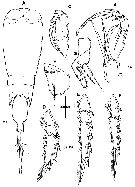 Issued from J.H. Wi, D.H. Kim & H.Y. Soh in Ocean Sci. J., 2013, 48 (4). [p.414, Fig.10]. As Agetus limbatus. Male: A, habitus (dorsal); B, A2; C, Mxp; D, exopodite of P1; E, exopodite of P2; F, exopodite of P3; G, P4 (intercoxal sclerite omitted); H, genital flap and P6. Scale bars in µm. Nota : Prosome 3-segmented, about 1.7 times as long as urosome including caudal ramus, 2.4 times of urosome length excluding caudal ramus. - 3rd prosomal segment with outer and inner epimeral extensions : outer one extended to anterior 40% of genital somite and inner one folds. - 2 large contiguous cuticular lenses adhered to each other on frontal part. - Genital somite oval, 1.7 times as long as maximum width at mid-region. Genital area formed into flaps derived from P6. - Anal somite rectangular-shaped, about 1.1 times as long as wide at base, with large opening distally in dotsal view, and 3.1 times shorter as long as genital somite. - Caudal ramus 4.9 times longer than wide at base, about 1/9 times shorter than genital somiyr. Armature similar to that of female, except for smaller length ratio of seta III to seta VII (1 : 1.5), compared to that of female (1 : 2.4). - A1 with segmentation and armature similar to that of female. - A2 similar to that of A. typicus, except 1st endopodal segment about 3.7 times as long as wide at base and 1stendopodal seta slightly longer (1.1 times) than coxopodal seta. - Mxp similar to that of A. typicus male, except distal endopodal segment relatively short, not extending ti inner proximal margin of syncoxa. - P1-P3 in segmentation and armature similar to those of female. Exopods of P1 to P3: length ratios of terminal spine to distal segment different from those of female, P1 to P3 slightly smaller (in P1 and P2 1.7 : 1, and in P3 1.1 : 1), length ratios of terminal spine to outer distal spine, in P1 almost equal (1.8 : 1), P2 and P3 slightly smaller (in P2 2.2 : 1 and in P3 3.7 : 1). - P4 similar to that of female, except relative length of terminal spine to proximal spine 1.7 times longer, and length of distal segment to terminal spine much longer (3.4 times), as compared to that of female. - P5 similar to that of female. - P6 represented by genital flap closing off each genital aperture, armed with long seta and sharply pointed process near its base, ornamented with curved row of denticles on anterior surface and 2 secretory pores on mid-region.
|
 Issued from J.H. Wi, D.H. Kim & H.Y. Soh in Ocean Sci. J., 2013, 48 (4). [p.406, Table 2]. As Agetus flaccus lapsus calami (C.R.). Female & Male: morphological characters. PR: prosome; UR: urosome; -CR: including CR; +CR: excluding CR: SUS/GS: 2nd urosomal somite/genital somite. Nota: Compare with Agetus flaccus and Agetus typicus.
|
 Issued from : H.B. Owre & M. Foyo in Fauna Caribaea, 1, Crustacea, 1: Copepoda. Copepods of the Florida Current, 1967. [p.12, Fig.14]. Female: 14, A2. Bsp 1 = Coxa; Bsp 2 = Basis.
| | | | | Ref. compl.: | | | Wilson, 1942 a (p.181); Massuti Alzamora, 1942 (p.106, Rem.); Sewell, 1948 (p.393, 461); C.B. Wilson, 1950 (p.194); Ganapati & Shanthakumari, 1962 (p.10, 16); Duran, 1963 (p.26); V.N. Greze, 1963 a (tabl.2); Björnberg, 1963 (p.85, Rem.); De Decker & Mombeck, 1964 (p.12); Neto & Paiva, 1966 (p.33, Table III); Furuhashi, 1966 a (p.295, vertical distribution in Oyashio/Kuroshio transitional area, Table 8); Mazza, 1966 (p.74); Séguin, 1968 (p.488); Delalo, 1968 (p.139); Dowidar & El-Maghraby, 1970 (p.268); Deevey, 1971 (p.224); Carli, 1971 (p.373, tab.2); Binet al., 1972 (p.69); Bainbridge, 1972 (p.61, Appendix Table I: vertical distribution vs day/night); Apostolopoulou, 1972 (p.329, 384); Guglielmo, 1973 (p.399); Boxshall, 1977 b (p.556); Dessier, 1979 (p.208); Vaissière & Séguin, 1980 (p.23, tab.2); Svetlichnyi, 1980 (p.28, Table 1, passive submersion); Vives, 1982 (p.296); Kovalev & Shmeleva, 1982 (p.86), Guangshan & Honglin, 1984 (p.118, tab.); Regner, 1985 (p.11, Rem.: p.42); M. Lefèvre, 1986 (p.33); Lozano Soldevilla & al., 1988 (p.61); Böttger-Schnack & al., 1989 (p.1089) ; Böttger-Schnack, 1995 (p.92); Shih & Young, 1995 (p.76); Suarez-Morales & Gasca, 1997 (p.1525); Hure & Krsinic, 1998 (p.105); Suarez-Morales & Gasca, 1998 a (p.112); Lapernat, 1999 (p.32); Siokou-Frangou, 1999 (p.479); Lavaniegos & Gonzalez-Navarro, 1999 (p.239, Appx.1); Seridji & Hafferssas, 2000 (tab.1); Lopez-Salgado & al., 2000 (tab.1); Lapernat & Razouls, 2001 (tab.1); Rezai & al., 2004 (p.490, tab.2); Lan & al., 2004 (p.332, tab.1); Lo & al., 2004 (p.89, tab.1); Isari & al., 2006 (p.241, tab.II); Dias & Araujo, 2006 (p.83, Rem., chart); Lavaniegos & Jiménez-Pérez, 2006 (p.141, tab.2, Rem.); Zervoudaki & al., 2006 (p.149, Table I); Khelifi-Touhami & al., 2007 (p.327, Table 1); Ayon & al., 2008 (p.238, Table 4: Peruvian samples); Lan Y.-C. & al., 2008 (p.61, Table 1, % vs stations); C.-Y. Lee & al., 2009 (p.151, Tab.2); Drira & al., 2010 (p.145, Tanl.2); Dias & al., 2010 (p.230, Table 1); Mazzocchi & Di Capua, 2010 (p.428); Medellin-Mora & Navas S., 2010 (p.265, Tab. 2); Hsiao S.H. & al., 2011 (p.475, Appendix I); Hsiao & al., 2011 (p.317, Table 2, indicator of seasonal change); Andersen N.G. & al., 2011 (p.71, Fig.3: abundance); Moscatello & al., 2011 (p.80, Table 4); Selifonova, 2011 a (p.77, Table 1, alien species in Black Sea); Shiganova & al., 2012 (p.61, Table 4); Uysal & Shmeleva, 2012 (p.909, Table I); Lidvanov & al., 2013 (p.290, Table 2, % composition); Bonecker & a., 2014 (p.445, Table II: frequency, horizontal & vertical distributions); Pansera & al., 2014 (p.221, Table 2, abundance); Mazzocchi & al., 2014 (p.64, Table 3, 4, occurrence); Zaafa & al., 2014 (p.67, Table I, occurrence); Dias & al., 2015 (p.483, Table 2, abundance, biomass, production); Benedetti & al., 2016 (p.159, Table I, fig.1, functional characters); Benedetti & al., 2018 (p.1, Fig.2: ecological functional group); Palomares-Garcia & al., 2018 (p.178, Table 1: occurrence) | | | | NZ: | 15 | | |
|
Carte de distribution de Corycaeus (Agetus) limbatus par zones géographiques
|
| | | | | | | | | | | | 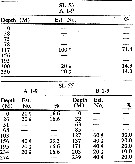 issued from : H.B. Owre & M. Foyo in Fauna Caribaea, 1, Crustacea, 1: Copepoda. Copepods of the Florida Current. 1967. [p.122, Table 63]. issued from : H.B. Owre & M. Foyo in Fauna Caribaea, 1, Crustacea, 1: Copepoda. Copepods of the Florida Current. 1967. [p.122, Table 63].
Vertical distribution of Corycaeus (A.) limbatus at the ''40-Mile Station'' in the Florida Current ( E Miami: ± 25°35'N, 79°27'W; depth 738 m).
SL 53: 18 V 1958; SL 55: 21 VII 1958. A: during midday; B: during midnight. |
| | | | Loc: | | | South Africa (E), Angola, Baia Farta, off E Ascension Is., G. of Guinea, Ivorian shelf, Dakar, Cape Verde Is., off Morocco-Mauritania, Canary Is., off Madeira, Portugal, off Macaé, Brazil (Rio de Janeiro, Campos Basin, off Vitoria-Cabo de Sao Tomé), Barbada Is., Caribbean Sea, Caribbean Colombia, Yucatan, G. of Mexico, Florida, off Bermuda, Sargasso Sea, off S Nova Scotia, off W Tangier, Medit. (Alboran Sea, Gulf of Annaba, El Kala shelf, Castellon, Banyuls, G. of Lion, Genoa, Tyrrhenian Sea, Milazzo, Lake Faro (Sicily), Gulf of Taranto, NW Tunisia, G. of Gabès, off Malta, Adriatic Sea, Vlora Bay, Ionian Sea, Aegean Sea, Thracian Sea, Black Sea, Lebanon Basin, W Egyptian coast, Alexandria), Red Sea, G. of Aden, Indian, India (Lawson's Bay), Straits of Malacca, Philippines, China Seas ( East China Sea, South China Sea), Taiwan Strait, Taiwan (E, NW, N: Mienhua Canyon), S Korea (Jeju Is.), Japan, Pacif. (W equatorial), Australia (Great Barrier, North West Cape), N New Zealand, Fidji Is., Moorea Is., Pacif. (tropical), W Baja California, La Paz, G. of California, Bahia Cupica (Colombia), Galapagos, Peru, off Chile | | | | N: | 133 | | | | Lg.: | | | (34) F: 1,45-1,32; (35) F: 1,45; (107) F: 1,36; M: 1,22; (180) F: 1,57-1,43; M: 1,24-1,16; (237) M: 1,4-1,3; (327) F: 1,64-1,47; M: 1,3-1,26; (340) M: 1,5; (618) F: 1,45-1,44; M: 1,26-1,21; (666) F: 1,35; M: 1,161-1,147; (667) M: 1,67-1,28; (668) F: 1,34; M: 1,48-1,43; (788) F: 1,32-1,24; M: 1,14-1,08; (920) F: 1,48; (1150)* F: 1,466-1,170; M: 1,230-1,236; {F: 1,24-1,64; M: 1,08-1,67}
*Total body length in lateral view. | | | | Rem.: | épi-mésopélagique, 3000 m (off Malte). 0-197 m at Station S2 in S Bösö (E middle Japan) from Furuhashi (1966 a).
Cette espèce est plus rarement citée dans les océans Indien et Pacifique.
Voir aussi les remarques en anglais | | | Dernière mise à jour : 25/10/2022 | |
|
|
 Toute utilisation de ce site pour une publication sera mentionnée avec la référence suivante : Toute utilisation de ce site pour une publication sera mentionnée avec la référence suivante :
Razouls C., Desreumaux N., Kouwenberg J. et de Bovée F., 2005-2025. - Biodiversité des Copépodes planctoniques marins (morphologie, répartition géographique et données biologiques). Sorbonne Université, CNRS. Disponible sur http://copepodes.obs-banyuls.fr [Accédé le 20 octobre 2025] © copyright 2005-2025 Sorbonne Université, CNRS
|
|
 |
 |


























